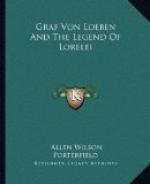The verse and strophe form, the rhyme scheme, the accent, the melody, except for Heine’s superiority, are the same in both. As to length, the two poems are exactly equal, each containing, by an unimportant but interesting coincidence, precisely 117 words.[56] But the contents of the two poems are not nearly so similar as they apparently seemed, at first blush, to Adolf Strodtmann. The melodious singing, the golden hair and the golden comb and the use that is made of both, the irresistibly sweet sadness, the time, “Aus alten Zeiten,” and the subjectivity—Heine himself recites his poem—these indispensable essentials in Heine’s poem are not in Loeben’s. Indeed as to content and of course as to merit, the two poems are far removed from each other.
And, moreover, literary parallels are the ancestors of that undocile child, Conjecture. We must remember that sirenic and echo poetry are almost as old as the tide of the sea, certainly as old as the hills, while as to the general situation, there is a passage in Milton’s Comus (ll. 880-84) analogous to Heine’s ballad, as follows:
And fair Ligea’s golden
comb,
Wherewith she sits on diamond
rocks,
Sleeking her soft alluring
locks,
By all the nymphs that nightly
dance
Upon thy streams with wily
glance,
and so on. And as to the pronounced similarity of form, we must remember that Heine was here employing his favorite measure, while Loeben was almost the equal of Ruckert in regard to the number of verse and strophe forms he effectively and easily controlled. In short, striking similarity in content is lacking, and as to the same sort of similarity in form to this but little if any significance can be attached.
And if the internal evidence is thin, the external is invisible, except for the fact that Loeben’s ballad was published by Brockhaus, whom Heine knew by correspondence. But between the years 1818 and 1847, Heine never published anything in Urania,[57] which was used by so many of his contemporaries. Heine and Loeben never knew each other personally, and between the years 1821 and 1823 they were never regionally close together.[58] Heine never mentions Loeben in his letters; nor does he refer to him in his creative works, despite the fact that he had a habit of alluding to his brothers in Apollo, even in his poems.[59]
And therefore, though it is fashionable to say that Heine knew Loeben’s ballad in 1823, and though the contention is plausible, it is impossible to prove it. Impossible also for this reason: Karl Simrock, Heine’s intimate friend, included in his Rheinsagen (1836, 1837, 1841)[60] the ballads on the Lorelei by Brentano, Eichendorff, Heine, and himself. Why did he exclude the one by Loeben? He made an ardent appeal in his preface to his colleagues to inform him of any other ballads that had been written on these themes. The question must be referred to those who like to skate on flabby ice in things literary.




